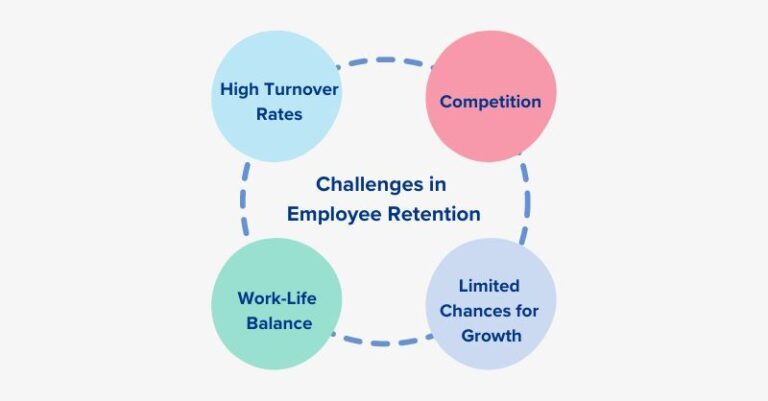Uncovering and Remedying Challenges in Employee Retention within the Workplace
Table of Contents

Challenges in Employee Retention

High Turnover Rates
There are many reasons involved in employee turnover, and it affects the organization widely. Constantly losing employees can disrupt workflow and require more money to hire new talent and train newly hired people. When employee retention decreases, it damages the company’s reputation and creates a bad impression among customers and clients. The basis for employee retention may include poor work-life balance, inadequate compensation, lack of career advancement and opportunities, ineffective management, and lack of recognition or rewards. These are just a few reasons for employee turnover in organizations.
Competition
Employee retention is mainly affected by the competition posed by competitors. In industries where skilled workers are highly demanded, retaining those talents becomes highly challenging. Competitors provide more perks, benefits, and better compensation packages to attract and retain talent.
Limited Chances for Growth
The primary method for professionals to grow is by enhancing their skills and knowledge. This will be achieved through seeking new responsibilities and experiences within their current roles. If the organization fails to meet employees’ needs for career advancement and skill development, they may seek opportunities elsewhere.
Work-Life Balance
Work-life balance involves finding a balance between professional responsibilities and personal life pursuits. It’s crucial for employee satisfaction and overall well-being. Nowadays, companies often demand excessive overtime or fail to accommodate personal needs, leading to various negative outcomes such as burnout, health issues, strained relationships, and decreased productivity.
These challenges indeed play significant roles in employee retention. Compensation and benefits, cultural mismatch, burnout and stress, and poor management are among the main factors affecting employee retention.
Strategies to Improve Employee Retention

Competitive Compensation and Benefits
Organizations must continuously review and modify salaries to provide employees with competitive compensation. Consider offering bonuses or other forms of compensation even if the business is currently unable to raise wages. It’s important to remember that enhancing retirement and healthcare benefits can also increase workers’ job satisfaction. Perks can make your workplace stand out to potential new hires and re-engage current staff, all while boosting employee morale.
A Well-defined Career Path
Providing opportunities for advancement and growth helps employees envision a future with the company, thus increasing their commitment and motivation to stay. As part of offering continuous feedback on performance, assisting employees in identifying areas for professional growth, such as the necessity to acquire new skills, is essential. Especially in today’s rapidly evolving technological landscape, upskilling employees remains crucial as technology continues to change the working style.
Positive Work Culture
Every employee in a company expects respect, encouragement, and support from management. Enhancing the positive work culture will be made easier with open and honest communication. Respect and trust for the company will grow as a result of how it handles its workers. A healthy work-life balance is also crucial for fostering a favorable workplace culture.
Managerial Training
The goal of managerial training is to help staff members shift from being team members to team leaders or, to put it another way, a single team manager’s contributor. It also emphasizes all the different soft skills that contribute to improved collaboration and fruitful partnerships. It is imperative to guarantee that they possess the abilities and resources required to guide with efficiency, offer assistance, and establish a happy workplace.
These four strategies, which encompass aspects such as pay, career advancement, workplace culture, and leadership, are essential components of the employee experience. Implementing them can significantly enhance retention rates and improve overall employee satisfaction.
VDart’s Human Performance practice offers innovative solutions to assist clients in tackling their most pressing people-related challenges. Leveraging cutting-edge approaches in Human Resource Process & Technology, Learning & Knowledge Management, Organization & Change Strategy, and Workforce Performance, we help clients optimize their human capital for sustained success.